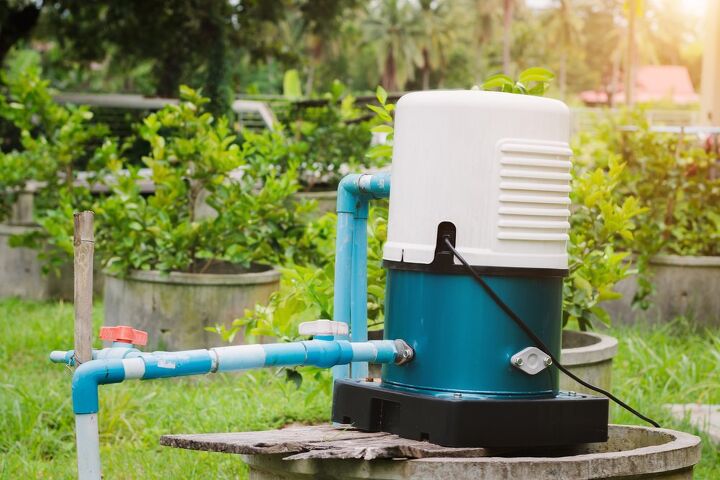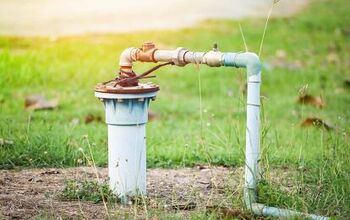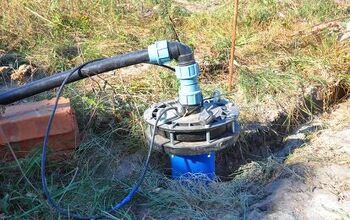How Much Does A Well Pump Cost?

Wells are a convenience and a staple in American homes for centuries now. The difference between the wells of days past and wells of today is the sophisticated simplicity of great well pumps. If you have a working well, you need a well pump, but what will it cost you?
The average cost to install a well pump is $1,925, and that includes labor and materials. It costs $1,600 to buy a well pump before installation, and another $325 in labor costs. You can expect to spend another $1,080 per year to run a well pump, and it costs $1,800 to replace an existing pump.
There are additional well pump costs, such as pipes and labor, which cost $150-$1,300 and $350-$500, respectively. Let’s take a close look at how much a well pump cost, and what to expect for installation.
Do You Need Well Pump Installation or Replacement?
Get free, zero-commitment quotes from pro contractors near you.

How Do Well Pumps Work?
Well pumps work by using a mechanical or manual mechanism to raise water. The method of raising the water is what separates one well pump from another. Some well pumps, such as jet pumps, use suction to create pressure to bring the water up.
Others work by pushing the water and delivering it to the top. Pumps direct water to an adjacent water storage tank, and from there goes to supply for the house. The water sits in the storage tank while it slowly increases pressure, and then it can be used by your family.
How Much Does a Well Pump Cost?
Well pumps typically cost between $150 and $3,700 without the cost of installation. There are several options for well pumps that vary in size and operation. Simple well pumps, such as hand pumps and shallow jets, only cost $150-$450.
However, once you get into submersible, deep jet, and solar well pumps, you can spend $1,600, or more. Powerful, high end, submersible pumps can cost well over $3,000. No matter which type of well pump you want, you’ll want to know the difference in cost and quality.
Solar Pump vs. Hand Pump
You couldn’t get more opposite than solar pumps and hand pumps. What they have in common is that they both leave as little of a carbon footprint as possible. They are both energy efficient and save you money in that regard, but the similarities stop there.
Solar Pump Price
Solar pumps cost up to $1,600 before installation, or more, but many builder-owners find it worth it. They have long lives, meaning you won’t have to worry about replacing your solar well pump. Solar pumps are 90% energy efficient due to the brushless motors and pumping mechanisms that they have.
The stainless steel construction and housing of most solar pumps are why they are so tough. As energy efficient as they are, solar panels come with extra costs. Since they are solar-powered, they require solar panels which adds to the bill.
However, most manufacturers offer solar well pumps with a solar panel included for between $1,600 and $2,500. Many solar well pumps can last up to 25 years or more, making the added costs worth the investment.
Hand Well Pump Cost
You can find hand well pumps for between $75 and $150. The low cost of hand well pumps is the biggest selling point for them, and it is a valid one. However, you should keep in mind that hand well pumps are considerably more labor-intensive than other options.
In fact, hand well pumps are the only labor-intensive well pump option. You must crank a hand well pump by hand, as the name implies, in order to get the water. In many ways, that makes them the most energy-efficient option, and it is definitely the cheapest one.
Many builder-owners install hand well pumps themselves because they are simple and quick. Since you could spend up to $300 on labor even for a hand pump, doing it yourself is a viable option.
Jet Pump vs. Submersible Pump
Jet pumps and submersible pumps are different not only in pricing but in how they work. Submersible well pumps make great use of energy by driving the water to the top. Jet well pumps do the opposite, and instead pull the water, which consumes more energy, but works well.
Jet Pump Cost
If you want a mid-range priced well pump, jet pumps fall in the middle. You typically only have to spend between $150 and $750 on jet pumps, but prices vary.
There are two main types of jet pumps: deep jet pumps, and shallow jet pumps. Deep-well jet pumps make use of pressure and suction to pull the water up. Shallow jet pumps work the same way but are for smaller depths near the surface.
Another type of jet pump is a convertible well pump. Convertible well pumps are a great investment because they work for wells of all sizes. You may also see jet pumps referred to as ejector pumps, which describes what they do.
Submersible Pump Price
Submersible pumps don’t use suction like jet pumps do, but they are arguably more effective. They are a type of centrifugal pump, but unlike those, submersible pumps can be submerged in water. Builder-owners use submersible pumps for everything from well and wastewater to breaking up solids.
You can find submersible pumps for as little as $180 from manufacturers like Goulds. Powerful submersible jets that deliver 5 horsepower cost as much as $3,700. Pumps on the high end of the price range are more capable of running smoothly and continuously for long periods.
Before you get into even installing a submersible pump, you probably need new pipes. Piping can get expensive, and you could spend an average of $1,300 on pipes before installation.
Well Pump Installation Cost
As always, installation is a big cost factor when it comes to well pumps. You can keep installation costs low by choosing simple pumps, such as deep and shallow jet pumps. If you choose jet pumps or hand pumps, you can pay $250-$300 for labor.
Otherwise, you typically pay $500 or more for labor-intensive installations, such as submersible or solar well pumps. There are added costs that come in with complicated pumps, such as the cost of solar panels and new pipes.
For example, if you need new pipes for your submersible pump, you could spend $4,000 or more. That price includes the pump itself, new pipes, and labor. However, it could be more or less based on the depth of the well and its conditions.
| Well Pump Type | Cost | Pipes Cost | Installation | Total Cost |
| Solar Pump | $1,600-$2,500 | $150-$200 | $500 | $2,250-$3,200 |
| Hand Pump | $75-$150 | $150-$200 | $250-$300 | $475-$650 |
| Jet Pump | $150-$750 | $150-$200 | $250-$500 | $550-$850 |
| Submersible Pump | $180-$3,700 | $300-$1,600 | $500 | $980-$5,800 |
Water Well Pump Pipes
No matter what kind of pump you choose, you’ll need pipes. As mentioned above, it can cost up to $1,300 on pipes for submersible pumps. However, it is significantly less for simpler well pumps.
For a standard shallow or deep jet pump, new pipes would cost between $150 and $200. You’ll also have to spend $50-$80 on wires for your water well pump. Wires and pipes are sold independently of the well pumps themselves, in most cases.
Well Pump Depth
Depth is an extremely important factor when it comes to well pumps. A well pump is rendered useless if it is not the same size as the well. It is rare for a well to go deeper than 900 feet, and most of them 120-700 feet deep.
| Well Pump Type | Depth |
| Shallow Jet Pump | 25 Feet |
| Deep Jet Pump | 24-400 Feet |
| 1 Horsepower Submersible Pump | 200 Feet |
| 5 Horsepower Submersible Pump | 800-1,000 Feet |
If you are not aware of how deep your well is, you can measure it. You can use an electronic sounder gauge to measure a well’s depth, but there are simpler DIY options. For example, many homeowners use a weighted bucket with a tape measure fixed to it attached to a string.
You can lower the weighted bucket and tape measure into the well until you reach the bottom. That will give you your measurement, and you can buy a well pump according to that.
Well Inspection Cost
It costs between $250 and $400 to get your well pump inspected. It is recommended that you get your well inspected every 10 years. However, if you suspect that something is wrong with your well pump, get it inspected now.
You can tell that something is wrong with your well by one of many ways, such as:
- Strange taste, smell, or consistency to your water
- Your energy bill is higher than it normally would be with your pump
- Faucets are acting up and spitting out water, or holding water in
- Sediment found in water
All of the above issues can tell you your well needs to be looked at. Before you make the call, take a look at your well yourself. Specifically, direct your attention to the well cap, and call someone if it is not fully on because it can contaminate the water.
How Much Does It Cost To Replace a Well Pump?
Replacing a well pump typically costs $1,600-$2,000. You won’t need to replace a well pump before 10 years unless there is something wrong with it. Well pump replacement is sometimes cheaper than installing one in the first place if there are already hookups, pipes, and wires in place.
Besides replacing old well pumps, you can also convert and repurpose them. For example, if you wanted to convert a jet pump to solar, you’d need to pay for solar panels and installation, but it wouldn’t cost the full $2,250-$3,200.
If your well pump replacement comes as the result of a failed inspection, add another $400 for the cost of inspection. You can save between $150 and $1,300 or more on replacing a well pump if your old pipes are useable.
Cost To Run Well Pump
Pumping water can take a lot of energy, but some are more energy-efficient than others. Submersible well pumps, for example, are energy efficient because they push water instead of pulling it. Other options, such as solar and hand pumps, are able to run at little to no cost.
As a general rule of thumb, the more horsepower you have, the more it costs to run the pump. A 5 horsepower water well pump could cost as much as $5-$6 to run each day. Conversely, a 1 horsepower well pump could cost as little as $1-$3 per day, or $30-$90 a month.
Running a well pump every day out of the year could cost between $360 and $1,800.
Related Questions
How long should a well pump last?
Well pumps typically last between 10 and 15 years. However, solar well pumps can last up to 25 years, but only if they are taken care of. Your 10 year well inspection can tell you what shape your well pump is in, and roughly how much longer you’ll have it.
How much does it cost to dig for a well?
It generally costs $4,500-$7,000 to dig a well. However, large wells can cost well over $10,000. Many professions charge $45-$60 per foot, and that adds up fast.
| Well Depth | Digging Cost |
| 100 Feet | $4,500-$6,000 |
| 125 Feet | $5,625-$7,500 |
| 200 Feet | $9,000-$12,000 |
| 400 Feet | $18,000-$24,000 |
| 800 Feet | $36,000-$48,000 |
The motor in your water well pump could be shorting out, and that trips the breaker. It could also be a case of faulty or damaged wiring, a short, or a damaged pump control switch. A professional can tell you what the problem is by looking at the wires or checking the motor.
What is a check valve on a well pump?A check valve is an important part of a well pump that stops backflow before it happens. You need a check valve on a well pump because it keeps the pressure on, literally, even when the pump is not running. If water does flow back, that can indicate that something is wrong with your check valve.
Do You Need Well Pump Installation or Replacement?
Get free, zero-commitment quotes from pro contractors near you.

Summing It Up
Well pumps typically cost $150-$3,700. There is an additional $250-$500 in labor costs, and $150-$1,300 for pipes. You should get your well pump inspected every 10 years, or sooner if you notice strange signs like foul-tasting water or faulty faucets.
Make sure that you know the exact depth of your well to make sure that you get the right well pump. Submersible well pumps and solar well pumps are a great option if you want to be energy efficient.

Nick Durante is a professional writer with a primary focus on home improvement. When he is not writing about home improvement or taking on projects around the house, he likes to read and create art. He is always looking towards the newest trends in home improvement.
More by Nick Durante



























